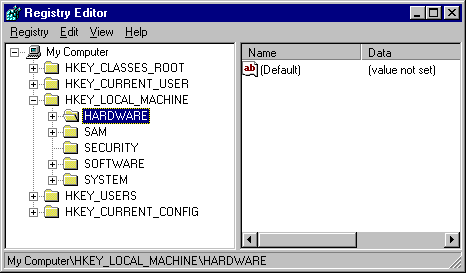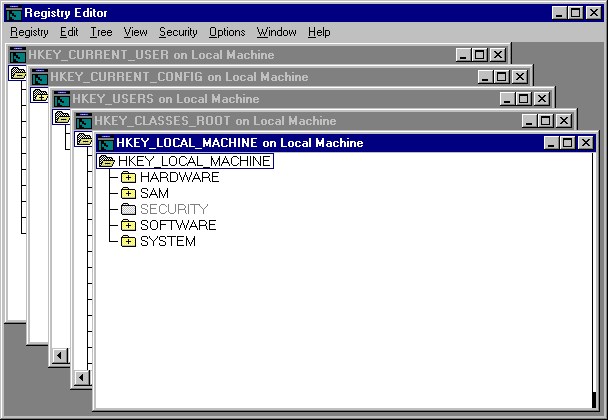
To get the most out of the material in this chapter, run a Registry editing tool so that you can see the contents of the Registry for your computer.
Windows NT 4.0 includes two tools for viewing and editing the Registry, both called Registry Editor. The traditional tool, Regedt32.exe, is documented more thoroughly in these chapters. The new tool, Regedit.exe, has a Windows NT Explorer interface. It has many of the same functions as Regedt32 and an expanded search capability. Both tools are installed automatically when you install Windows NT on any computer.
Figure 23.1 shows the Windows NT Registry as seen by Regedit:

Figure 23.1 The Registry as viewed by Regedit
1. Start Regedt32.exe or Regedit.exe from Windows NT Explorer, or click Run on the Start menu.
– Or –
Type regedt32 or regedit at the command prompt, and press ENTER.
2. From the Options menu in Regedt32, click Read Only Mode.
This enables the Regedt32 read-only mode, which protects the Registry contents from unintentional changes while you explore its structure and become familiar with the entries.
3. Click any folder icon to display the contents of that key.
In Regedit, click Find on the Edit menu to search for keys and subkeys, value entries, and values. In Regedt32, click Find Key on the View menu to search for a key or subkey. However, you cannot search for value entries or values by using the Find Key command in Regedt32.
For more information about Regedt32 and Regedit, click Help Topics on the Help menu of either application.
For details about security and backup measures to take with the Registry and other issues, see Chapter 24, "Registry Editors and Registry Administration."
Figure 23.2 shows the Windows NT Registry as seen by Regedt32.

Figure 23.2 The Windows NT Registry as viewed by Regedt32
The Registry is a database, and Registry Editor displays the five subtrees used to access the contents of the database. The hierarchical structure that appears in Registry Editor looks similar to the hierarchical directory structures in Windows NT Explorer. The information in this chapter helps you understand where specific kinds of information can be found in the Registry and where you should or should not make changes.
In this chapter, the Registry keys are described in the same order as the order in which they appear in the Registry Editor windows. The information on Registry keys in this chapter focuses on those parts of the Registry that a system administrator is most likely to need to view or to change. Some information is provided merely to explain what is stored in certain keys.
The content or location of an individual Registry key on your computer might differ from what is described in these chapters. The Registry configuration depends on the services and software installed, on whether the computer is running Windows NT Workstation or Windows NT Server, and on other factors. However, you can use the general organization described in this chapter to help you understand how to navigate in Registry Editor.
Note
Registry entries that system administrators most commonly examine or edit are found under HKEY_LOCAL_MACHINE\System\CurrentControlSet, described later in this chapter. Specific entries are defined in Regentry.hlp, a Help file included on the Windows NT Workstation Resource Kit CD.